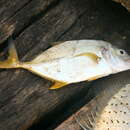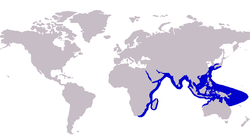mk
имиња во трошки


Die Swarttip-koningvis (Caranx heberi) is 'n vis wat voorkom in die Indiese-Pasifiese area en aan die ooskus van Afrika vanaf die Persiese Golf tot by Knysna. In Engels staan die vis bekend as die Blacktip kingfish.
Die vis het 'n gevurkte stertvin met die boonste helfte wat swart is en die onderste helfte geel terwyl die anale en dorsale vinne tot helder geel kan wees. Die pektorale vinne is lank en op die agterste helfte van die sylyn is 'n ry verdikte skubbe. Die vis word 1 m lank en 14 kg swaar.
Die verkies rots en koraalriwwe om in te leef in water wat van 5 – 20 m diep is terwyl die onvolwasse visse riviermondings en die vlak kuswater verkies om in te leef. Die vis eet vis wat op die riwwe leef, ansjovis, tjokka, garnale en klein krappe.
Die Swarttip-koningvis (Caranx heberi) is 'n vis wat voorkom in die Indiese-Pasifiese area en aan die ooskus van Afrika vanaf die Persiese Golf tot by Knysna. In Engels staan die vis bekend as die Blacktip kingfish.
Caranx heberi és un peix teleosti de la família dels caràngids i de l'ordre dels perciformes.[2]
Pot arribar als 85 cm de llargària total i als 12,5 kg de pes.[3]
Es troba des de les costes de l'Àfrica Oriental i Madagascar fins a les de Fidji, Ryukyu i nord d'Austràlia.[3]
The blacktip trevally (Caranx heberi), also known as the blacktip kingfish or yellowtail kingfish, is a species of large marine fish classified in the jack family Carangidae. The blacktip trevally is distributed throughout the tropical to subtropical Indian and West Pacific Oceans, ranging from South Africa in the west to Fiji, Japan and northern Australia in the east. It inhabits coastal waters throughout its range, preferring moderately deep clear waters over rocky and coral reefs. The blacktip trevally is easily distinguished by its yellow fins and a dark upper caudal fin lobe which gives the species its common name, as well as a host of other anatomical features. The species is known to reach a maximum size of 1 m. It is a benthopelagic predator, commonly forming small shoals where it takes a variety of fishes, cephalopods and crustaceans as prey. Little is known of reproduction in the species, and spawning is assumed to take place in more tropical regions of its range, with juveniles known to inhabit bays and large estuaries. Blacktip trevally are often caught using hook and line and various nets in commercial fisheries although don't make up a large part of the market. They are also popular with anglers due to their fighting ability and decent table qualities.
The blacktip trevally is classified within the genus Caranx, one of a number of groups known as the jacks or trevallies. Caranx itself is part of the larger jack and horse mackerel family Carangidae, which in turn is part of the order Carangiformes.[3]
As currently accepted, the species was first scientifically described by John Whitchurch Bennett in 1830 based on the holotype specimen taken from the south coast of Sri Lanka.[4] He named this new species Scomber heberi, placing it in the mackerel genus which at that time was a common genus for placing carangid fishes. The origin of the specific epithet is unclear, with it possibly named after someone or relate to the German word Heber, meaning "lob".[4] With the creation of the genus Caranx, the species was transferred there, where it has remained. There is some confusion over a species described by Peter Forsskål in 1775 under the name Scomber sansun and later transferred to Caranx sansun. This species is still listed as valid by some authorities, although a 1968 review of the taxon by J.L.B. Smith failed to find the holotype and suggested a new name with holotype be introduced to replace it; Caranx williamsi.[5] This name was sunk into C. heberi by William Smith-Vaniz in a major review, indicating C. sansun also should be sunk.[6] Despite this, the name remains valid amongst some authorities. A second, later independent description of the fish by Georges Cuvier produced the name Caranx sem, which became common throughout the literature. Probable synonymy with C. heberi was recognized by Henry Fowler in 1905[7] and is currently recognized as such due to formal synonymisation by John Randall.[8][9]
The blacktip trevally is distributed throughout the tropical and subtropical waters of the Indian and West Pacific Oceans.[9] In the western part of its range, the species ranges from South Africa and Madagascar north along the east African coast up to the Persian Gulf and Red Sea.[10] Its distribution continues eastward through India, South East Asia and the Indonesian Archipelago. Its range extends south to northern Australia, north to Japan,[11] and to Fiji in the east.[9][2]
The blacktip trevally is predominantly an inshore species, frequenting clean open coastal waters as an adult, with juveniles also found in large bays and estuaries.[12] Adults are often found over moderately deep rocky reefs and pinnacles as well as open sandy areas.[13]
The blacktip trevally is a large fish, growing to a maximum recorded size of 1 m in length and 12.5 kg in weight.[2] It is similar to most other jacks in having a compressed, oblong body, with the dorsal profile much more convex than the ventral profile, particularly anteriorly. The dorsal fin is in two distinct sections; the first consisting of 8 spine and the second of 1 spine and 19 to 21 soft rays. The anal fin consists of 2 anteriorly detached spines followed by 1 spine and 15 to 17 soft rays.[14]
The ventral fin consists of 1 spine and 5 soft rays, while the caudal fin is strongly forked.[7] The species lateral line is moderately arched anteriorly, with 50 to 60 scales in this section, while the straight section contains 0 to 4 scales and 30 to 40 strong scutes.[15] The pattern of breast scales is variable, ranging from fully scaled to naked ventrally. The species has moderately well developed adipose eyelids, while its dentition consists of an outer row of widely spaced canines and an inner band of villiform teeth in the upper jaw and a row of widely spaced conical teeth on the lower jaw. The blacktip trevally has 24 to 27 gill rakers and 24 vertebrae.[9]
The blacktip trevally's colouration is distinctive, with the upper body being dark bronze to yellow green while the lower body fades to silvery white below. The caudal fin is bright to olive yellow, with the top half normally black to dark, giving the species its common name. Other fins range from bright yellow to dusky with little yellow at all. The species also lacks the dark spot on the opercular margin that many related species possess.[9][15]

The blacktip trevally travels in both small shoals and individually throughout its habitat, with juveniles more commonly found in shoals. They appear to be migratory, with South Africa recording influxes of the species in summer,[12] while in India they arrive after the monsoons and continue their inhabitance through the cold months.[16] The species is a benthopelagic predator, taking its prey from the sea floor and higher in the water column. Prey items include a variety of fish, cephalopods, and crustaceans including shrimps, mantis shrimps, crabs and crayfish.[12] Reproduction in the species is poorly understood, although observations indicate it spawns in the more tropical regions of its range,[12] with sexual maturity reached at 50 cm.[2]
The blacktip trevally is of minor importance to commercial fisheries throughout its range, taken by hook and line and various netting methods, from where it is sold fresh, salted or dried at market.[9] The species is considered a good gamefish and can be taken by fish or squid baits as well as various patterns of lure and fly.[13] When taken from the water, the fish often 'grunt' in similar manner to a young pig.[16] They are considered an excellent table fish despite being known to be a host to parasitic infection in some regions.[12] The IGFA all tackle world record for the species stands at 8.20 kg (18 lb 1 oz) caught off Bazaruto Island, Mozambique in 2008.[17]
The blacktip trevally (Caranx heberi), also known as the blacktip kingfish or yellowtail kingfish, is a species of large marine fish classified in the jack family Carangidae. The blacktip trevally is distributed throughout the tropical to subtropical Indian and West Pacific Oceans, ranging from South Africa in the west to Fiji, Japan and northern Australia in the east. It inhabits coastal waters throughout its range, preferring moderately deep clear waters over rocky and coral reefs. The blacktip trevally is easily distinguished by its yellow fins and a dark upper caudal fin lobe which gives the species its common name, as well as a host of other anatomical features. The species is known to reach a maximum size of 1 m. It is a benthopelagic predator, commonly forming small shoals where it takes a variety of fishes, cephalopods and crustaceans as prey. Little is known of reproduction in the species, and spawning is assumed to take place in more tropical regions of its range, with juveniles known to inhabit bays and large estuaries. Blacktip trevally are often caught using hook and line and various nets in commercial fisheries although don't make up a large part of the market. They are also popular with anglers due to their fighting ability and decent table qualities.
Caranx heberi es una especie de peces de la familia Carangidae en el orden de los Perciformes.
Los machos pueden llegar alcanzar los 85 cm de longitud total y los 12,5 kg de peso.[1]
Se encuentra desde las costas del África Oriental y Madagascar hasta las de Fiyi, Ryukyu y norte de Australia.
Caranx heberi es una especie de peces de la familia Carangidae en el orden de los Perciformes.
Caranx heberi Caranx generoko animalia da. Arrainen barruko Carangidae familian sailkatzen da.
Espezie hau Agulhasko itsaslasterran aurki daiteke.
Caranx heberi Caranx generoko animalia da. Arrainen barruko Carangidae familian sailkatzen da.
Carangue à pointe noire, Carangue cocole
Caranx heberi, communément nommé Carangue à pointe noire ou Carangue cocole, est une espèce de poisson marin de la famille des Carangidae.
La Carangue à pointe noire est présente dans les eaux tropicales de l'Indo/ouest Pacifique[2].
Sa taille maximale est de 85 cm mais la taille moyenne couramment observée est de 30 cm et la maturité sexuelle est atteinte à la taille de 50 cm[3].
Carangue à pointe noire, Carangue cocole
Caranx heberi, communément nommé Carangue à pointe noire ou Carangue cocole, est une espèce de poisson marin de la famille des Carangidae.
La Carangue à pointe noire est présente dans les eaux tropicales de l'Indo/ouest Pacifique.
Sa taille maximale est de 85 cm mais la taille moyenne couramment observée est de 30 cm et la maturité sexuelle est atteinte à la taille de 50 cm.
Caranx heberi is een straalvinnige vissensoort uit de familie van horsmakrelen (Carangidae).[2] De wetenschappelijke naam van de soort is voor het eerst geldig gepubliceerd in 1830 door Bennett.
Bronnen, noten en/of referenties 分類 界 : 動物界 Animalia 門 : 脊索動物門 Chordata 亜門 : 脊椎動物亜門 Vertebrata 綱 : 条鰭綱 Actinopterygii 目 : スズキ目 Perciformes 亜目 : スズキ亜目 Percoidei 科 : アジ科 Carangidae 亜科 : アジ亜科 Caranginae 属 : ギンガメアジ属 Caranx 種 : イトウオニヒラアジ C. heberi 学名 Caranx heberi
分類 界 : 動物界 Animalia 門 : 脊索動物門 Chordata 亜門 : 脊椎動物亜門 Vertebrata 綱 : 条鰭綱 Actinopterygii 目 : スズキ目 Perciformes 亜目 : スズキ亜目 Percoidei 科 : アジ科 Carangidae 亜科 : アジ亜科 Caranginae 属 : ギンガメアジ属 Caranx 種 : イトウオニヒラアジ C. heberi 学名 Caranx heberi
イトウオニヒラアジ(学名:Caranx heberi)はアジ科に分類される大型の海水魚である。インド洋と西太平洋の熱帯、亜熱帯域に広く生息し、分布は西は南アフリカから東はフィジー、日本、オーストラリア北部にまで広がっている。生息域の全域において沿岸海域でみられ、岩礁などのある比較的深く透明度の高い海域を好む。鰭が黄色であることや尾鰭上部が黒味を帯びること、その他の解剖学的特徴などから近縁他種と容易に区別できる。最大で全長88cmに達する。しばしば小さな群れを形成し様々な種類の魚類、頭足類、甲殻類を捕食する。繁殖について分かっていることはわずかであるが、産卵は生息域のうち熱帯域で行われ、幼魚は湾や大きなエスチュアリーに生息することが知られている。様々な漁法によりしばしば漁獲されるが市場にはそれほど出回らない。引きが強く、また美味であることから釣りの対象魚としても人気がある。
イトウオニヒラアジはスズキ目アジ科のギンガメアジ属に属する[1]。
本種はJohn Whitchurch Bennettによって1830年に、スリランカの南岸から得られた標本をホロタイプとして初めて記載された[2]。彼はこの種をScomber heberiと名付け、当時他の多くのアジ科魚類も属していたサバ科のサバ属(Scomber)に分類した。種小名の由来は定かではないが、誰かに献名されたものであるか、あるいは「持ち上げるもの」などといった意味をもつドイツ語の単語"Heber"に由来するのではないかと言われている[2]。ギンガメアジ属(Caranx)の創設とともに本種はギンガメアジ属に移され、現在でもこの分類が正当とされる。ペール・フォルスコール(英語版)によって1775年にScomber sansunとして記載され、のちにギンガメアジ属に移されたCaranx sansunという種についても本種と同種と見なされている。この種はいくつかの文献においては未だ有効とされるが、1968年にジェームズ・レナード・ブライアリー・スミス(英語版)によるタクソンの見直しを行った研究の中で、この種のホロタイプが失われていることが指摘され、新しいホロタイプに基づいてCaranx williamsiという学名に変更することが提唱された[3]。その後1986年にWilliam Smith-Vanizによって、C. williamsiとC. sansunの両学名は本種のシノニムとして無効にするべきだとされた[4]。それにも関わらずC. williamsiという種もいくつかの文献では正当とされている。他にもジョルジュ・キュヴィエが記載したCaranx semという種も、1905年にヘンリー・W・ファウラー(英語版)により本種のシノニムではないかと提唱された[5]。この学名はその後、John Randallの報告に基づき本種のシノニムと認められている[6][7]。
イトウオニヒラアジは大型魚であり、体長は全長88cm、体重は12.5kgが最大記録である[8]。体型は他のアジ科魚類と同様側偏した楕円形であり、背側が腹側よりもふくらんでいる。背鰭は2つの部分に分かれており、第一背鰭には8本の棘条が、第二背鰭には1本の棘条と19本から21本の軟条が存在する。臀鰭は2本の棘条が前方に分離し、その後方に1本の棘条とそれに続く15本から17本の軟条が存在する[9]。
腹鰭は1本の棘条と5本の軟条からなる。尾鰭は二又に分かれている[5]。 側線は前方でやや湾曲し、曲線部には50から60の鱗が、直線部には0から4の鱗と30から40の稜鱗(英語版)(アジ亜科に独特の鱗)が存在する[10]。胸部については、鱗でその全体が覆われていることもあれば、腹側には鱗が存在しないこともある。眼には脂瞼(英語版)(透明な瞼状の部分)が発達している。上あご外側には犬歯からなる隙間の広い歯列が、内側には絨毛状歯からなる歯列が存在する。下顎には円錐状の歯からなる隙間の広い歯列が一列存在する。鰓篩数は24から27、椎骨数は24である[7]。
本種は特徴的な体色をもつ。体の上部は暗い青銅色から黄緑色で、下部に至るにつれ銀白色となる。尾鰭は明るい黄色からオリーブ色を帯びた黄色で、頂部はふつう黒色である。その他の鰭は黄色である。近縁の多くの種とは違い、鰓蓋上に班はもたない[7][10]。
イトウオニヒラアジはインド洋、西太平洋の熱帯、亜熱帯域に広く生息する[7]。 生息域は西部では南アフリカやマダガスカルから東アフリカ沿岸に沿ってペルシャ湾、紅海まで北へと広がっている[11]。生息域は東へそのまま伸び、インド、東南アジア、マレー諸島を含む。南はオーストラリア北部、北は日本、東はフィジーが生息域の端となっている[7][8][12]。
日本においては鹿児島県南さつま市の沖から採集された2個体の若魚に基づいて2007年にはじめて報告された。これは本種の北半球からの初記録でもあった[12]。この際オニヒラアジ(Caranx papuensis)との形態的類似、そして採集者である伊東正英の名前に基づき、イトウオニヒラアジという和名が提唱された[12][13]。
沿岸性であり、成魚は水質のきれいな沿岸海域でよくみられ、幼魚は大きな湾やエスチュアリーでもみられる[14]。成魚はしばしば比較的深い岩礁や開けた砂地でもみられる[15]。
イトウオニヒラアジは小さな群れ、あるいは単独で行動する。未成魚は群れで行動することが多い。 一年の間に回遊をすることが知られており、本種は南アフリカでは夏に流入する[14]一方、インドではモンスーンが吹くと流入し寒い時期をその海域で過ごす[16]。本種は肉食魚であり、海底近くとより浅い海域の両方で獲物を捕食する。 捕食対象には様々な魚、頭足類、エビやシャコ、カニなどの甲殻類が含まれる[14]。繁殖については不明な点が多いが、産卵は熱帯域で行われ[14]、性成熟には全長50cmほどで達することが観察により推測されている[8]。
イトウオニヒラアジは生息域全域で漁業においてあまり重要な種ではないが、様々な漁法によって捕獲され鮮魚、干物、塩漬けなどで販売される[7]。釣りの対象として人気があり、魚やイカを餌として、あるいはルアーなどを用いて釣られる[15]。水から引き上げたとき、しばしば子豚の鳴き声のような音を出すことが知られている[16]。肉は美味であるとされるが、地域によっては寄生虫を媒介する事例も知られている[14]。
イトウオニヒラアジ(学名:Caranx heberi)はアジ科に分類される大型の海水魚である。インド洋と西太平洋の熱帯、亜熱帯域に広く生息し、分布は西は南アフリカから東はフィジー、日本、オーストラリア北部にまで広がっている。生息域の全域において沿岸海域でみられ、岩礁などのある比較的深く透明度の高い海域を好む。鰭が黄色であることや尾鰭上部が黒味を帯びること、その他の解剖学的特徴などから近縁他種と容易に区別できる。最大で全長88cmに達する。しばしば小さな群れを形成し様々な種類の魚類、頭足類、甲殻類を捕食する。繁殖について分かっていることはわずかであるが、産卵は生息域のうち熱帯域で行われ、幼魚は湾や大きなエスチュアリーに生息することが知られている。様々な漁法によりしばしば漁獲されるが市場にはそれほど出回らない。引きが強く、また美味であることから釣りの対象魚としても人気がある。